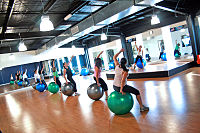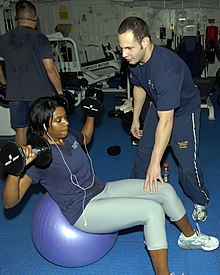Swiss ball
A Swiss ball is a soft and resistant elastomer balloon with a large diameter (35-85 cm) filled with air. It is used for physiotherapy, rehabilitation and physical exercise. It serves to improve balance and coordination, strengthen the back and abs, among others.
The Swiss ball is used in the area of physiotherapy and in recent years a series of exercise techniques have been replaced by the use of this ball. This discipline is known by the name of Spherodynamics.
Synonyms
The Swiss ball is known by different names such as ball or ball: balance, stability, exercises, gymnastics, fitness, pilates, therapeutic, body, spheroball, physioball, bobath, birthing ball or ball of yoga. In English fitball, physioball, teraphy ball, Pezzi® ball.
History
The Swiss ball was developed in 1963 by Aquilino Cosani, an Italian plastics manufacturer. He perfected a process of molding large balls of sharp-resistant plastic. These balls, then known as "Pezzi balls", were first used in newborn and infant treatment programs by Mary Quinton, a British physiotherapist working in Switzerland. Later, Dr. Susanne Klein-Vogelbach, director of the School of Physical Therapy in Basel, Switzerland, integrated the use of the exercise ball as physical therapy for neurodevelopmental treatment. Based on the concept of 'functional kinetics', Klein-Vogelbach advocated the use of balloon techniques for the treatment of adults with orthopedic or medical problems.
The term "Swiss ball" it came into use when American physical therapists began using these techniques in North America after seeing their benefits in Switzerland. From their development as physical therapy in a clinical setting, these exercises are used in sports training, as part of a general fitness routine and incorporation into alternative exercises such as yoga and Pilates.
Size of the ball
The size of the ball is chosen according to the height:
| Diameter | Height |
|---|---|
| 45cm | 1.50 m |
| 55cm | 1.60m |
| 65cm | 1.70m |
| 75 cm | Up to 1.8m |
| 85 cm | mainly employed in |
Benefits
One of the advantages of exercising with a Swiss ball instead of exercising it on a flat, hard surface such as the ground, is that the body responds to the instability of the ball by remaining balanced, involving many more muscles in its execution. Muscles over time become stronger to maintain balance. The main muscles of the body, the abdominal muscles and the back muscles, are the focus of a Swiss ball exercise program. It is also a low-impact exercise so it can be performed by people of all ages in a healthy way. practical, safe, and does not require specific physical preparation. This type of gymnastics is recommended for people who suffer from cervical and lumbar pain and also for pregnant women, since it corrects bad postures almost immediately.


